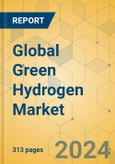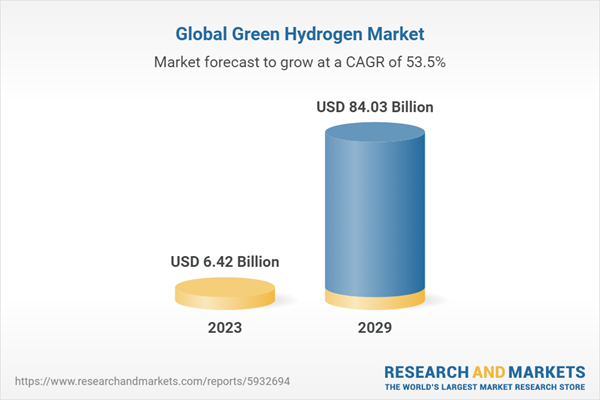Speak directly to the analyst to clarify any post sales queries you may have.
MARKET OUTLOOK
Green hydrogen is produced by splitting water into hydrogen and oxygen using renewable electricity. This is quite a different pathway compared to gray and blue hydrogen. The green hydrogen market is in its nascent stage. Still, it holds substantial potential in addressing the challenges and limitations associated with directly replacing fossil fuels with electricity, particularly in industries requiring intense heat for processes such as steel, cement, glass, and chemicals. This unique capability positions hydrogen as a key player in decarbonizing industrial sectors, complementing electric arc furnaces (EAF) technologies in steelmaking.Green hydrogen is emerging as a versatile and environment-friendly energy carrier in industries such as steelmaking. Moreover, the industrial sector can benefit from the green hydrogen market as a feedstock for the cleaner production of essential chemicals, including ammonia and organic. Green hydrogen is poised to play a crucial role, particularly in sectors such as shipping, aviation, and, to a lesser extent, heavy goods vehicles. The synthetic fuels derived from hydrogen, such as ammonia and methanol, and fuel cell technology offer promising solutions for decarbonizing these challenging sectors. However, it has been acknowledged that hydrogen faces stiff competition from other alternative fuel options, particularly battery electric vehicles, in light-duty vehicles such as passenger cars.
Presently, the European region stands out as a leader in implementing green hydrogen commercialization plants and supports the growth of the green hydrogen market. In contrast, areas including Latin America, the Middle East, and Asia Pacific are positioning themselves as future export hubs. The Middle East & Africa (MEA) region has abundant renewable energy sources, such as solar and wind, allowing the production of green hydrogen at a lower cost. This competitive advantage positions the MEA as a significant region in the export market, potentially challenging the established players in Asia Pacific and Europe.
FUTURE EXPORTERS OF GREEN HYDROGEN
India aims to become a leading exporter of green hydrogen, targeting a production goal of 5 million tons per year by the end of the decade. The country, currently focused on green hydrogen research facilities, is anticipating export markets to drive demand, allowing it to leverage its low production costs and emerge as a critical supplier. Despite objections from oil refiners, the government announced the launch of 48 projects capable of producing 3.5 million tons annually in 2023. The demand from the fertilizer industry is considered a potential avenue, and the government has released guidelines and USD 2.1 billion in subsidies to support the hydrogen sector, which includes electrolyzer manufacturers. However, domestic users may face challenges transitioning from gray to green hydrogen without demand-side incentives. Globally, the International Energy Agency (IEA) will demand about 180 million tons of hydrogen by 2030, allowing India to capture a significant share.IMPACT OF TECHNOLOGY
The key technology for producing green hydrogen involves electrolysis, where an electrolyzer utilizes electricity from renewable sources to split water into hydrogen and oxygen. However, electrolyzers currently contribute significantly to the final cost of hydrogen production, making it imperative to create scale economies in manufacturing and enhance their performance for cost-effective clean hydrogen.The electrolyzer technology is currently in its infant stage, rendering it relatively expensive for widespread adoption by countries. This high cost acts as a deterrent for underdeveloped nations from investing significantly in this technology. However, green hydrogen production costs will decrease as the market matures due to the emergence of cost-effective and advanced technologies. Reducing the cost of electrolyzers will play a pivotal role in making this renewable energy source more economically viable.
The potential impact of technology in the green hydrogen market extends beyond cost reduction. With continuous technological advancements, the efficiency of electrolysis processes is slated to improve, resulting in higher production yields and further contributing to cost-effectiveness. Moreover, the transition to green hydrogen depends on technological advancements, supportive policies, and international collaborations. Governments and regulatory bodies play a crucial role in incentivizing the adoption of green hydrogen technologies through subsidies, tax breaks, and research funding initiatives. The collaborative efforts at the global level can facilitate the exchange of knowledge and expertise, thereby accelerating the development and dissemination of cost-effective green hydrogen technologies.
SEGMENTATION INSIGHTS
INSIGHTS BY TECHNOLOGY
The alkaline electrolyzer technology accounted for the highest global green hydrogen market share in 2023. As the oldest electrolysis technology, alkaline electrolyzers are most widely deployed globally owing to the continuous stream of advancements and innovations in recent years. PEM electrolyzers are the second most preferred technology worldwide; their extended lifespan and superior efficiency distinguish them from alkaline electrolyzers. Alkaline and PEM electrolyzers possess distinct competitive advantages despite being technologically advanced and commercially available. Alkaline electrolyzers stand out for their cost-effectiveness in terms of installation, while PEM electrolyzers account for a significantly smaller physical footprint. Additionally, PEM electrolyzers boast of higher production rates and output pressures.Segmentation by Technology
- Alkaline Electrolyser
- Proton Exchange Membrane Electrolyzer
- Others
INSIGHTS BY SOURCE
The global green hydrogen market by source is segmented into wind, solar, and others. Wind energy, mainly onshore wind, has the largest share in powering green hydrogen production. Its abundance and cost-competitiveness make it a leading choice. Solar energy, while being slightly behind wind, is rapidly catching up. Its potential for decentralized production and integration with existing grids is appealing. Other sources in the green hydrogen market include geothermal, hydropower, and hybrids, which account for smaller shares but are slated to register the highest CAGR. Furthermore, the Middle East and North Africa (MENA) region, particularly the Gulf Cooperation Council (GCC) states, possess abundant renewable energy resources such as solar and wind power; this makes the region an ideal location for green hydrogen production. The UAE, in particular, benefits from the lowest solar power cost globally.Segmentation by Source
- Wind Energy
- Solar Energy
- Others
INSIGHTS BY END USER
The global green hydrogen market by end-user is segmented into refining, ammonia, and others. Green hydrogen can be applied as a feedstock in industries such as ammonia, methanol, refining, and steel; it can also be used as an energy carrier in fuel cells, energy storage, transportation fuel, and process heating. Among these options, the refining sector stands out as a critical player, accounting for the highest market share. Furthermore, the refining market is adopting green hydrogen as a sustainable and low-carbon alternative to traditional hydrogen production methods, aligning with global efforts to reduce carbon emissions. As the demand for cleaner energy sources intensifies, green hydrogen is becoming a preferred choice for refineries aiming to enhance their environmental performance and comply with stringent regulatory standards. Additionally, the ammonia production sector is emerging as a consumer of green hydrogen, further contributing to the diversification of end-user demand within the growing green hydrogen market.Segmentation by End Users
- Refining
- Ammonia
- Others
GEOGRAPHICAL ANALYSIS
Europe accounted for the highest global green hydrogen market share, valued at over USD 2 billion in 2023. The European Union, mainly through initiatives such as the 2050 Low Carbon Strategy (published in 2018) and the Green Pact for Europe (presented in 2019), has outlined comprehensive plans to decarbonize a significant portion of its renewable electricity energy consumption. A vital component of this strategy involves leveraging hydrogen as a renewable energy storage medium to address the gaps in energy needs. The EU aims to increase the share of hydrogen in its energy mix from 2% to potentially 14% by 2050, thereby recognizing its potential to effectively reduce and replace fossil fuels in the challenging-to-decarbonize sectors such as steel, chemicals, and transport. Such factors are projected to support the market growth during the forecast period.Segmentation by Geography
- Europe
- Germany
- Spain
- France
- Portugal
- Italy
- APAC
- China
- India
- Japan
- Australia
- South Korea
- North America
- US
- Canada
- Middle East & Africa
- Egypt
- Morocco
- South Africa
- Saudi Arabia
- UAE
- Latin America
- Chile
- Brazil
- Mexico
- Argentina
COMPETITIVE LANDSCAPE
The global green hydrogen market is marked by a diverse competitive landscape, encompassing various technologies and players across different segments. Several companies actively contribute to the industry's development, with competition arising from traditional hydrogen production methods, green hydrogen technology providers, and companies selling green hydrogen as an end product. The traditional hydrogen production methods, represented by established players including Linde, Air Liquide, and Air Products and Chemicals, continue to optimize efficiency and reduce costs. These companies pose a challenge to adopting green hydrogen as the improvements in traditional methods may impact the cost-effectiveness of the transition to greener alternatives.Key Company Profiles
- Nel
- ITM Power
- ENGIE
- Siemens Energy
- Air Products and Chemicals
Other Prominent Vendors
- McPhy Energy
- Loop Energy
- Messer
- Elcogen
- LONGi
- John Cockerill
- Plug Power
- Cummins
- Genvia
- Air Liquide
- Linde
- Bloom Energy
- Uniper
- FuelCell Energy
- Toshiba Energy Systems & Solutions Corporation
- FUSION-FUEL
- thyssenkrupp AG
- Enapter
- Ørsted
- HydrogenPro
- Topsoe
- Sunfire
- H2 Green
- NTPC REL
- Green Hydrogen Systems
- Lhyfe
- Iberdrola
- Enel Green Power
- Beijing SinoHy Energy
- GUOFUHEE
- Sungrow Power Supply
- Shandong AUYAN New Energy Technology
- Purification Equipment Research Institute of CSIC
- Kohodo Hydrogen Energy
- Ohmium
KEY QUESTIONS ANSWERED:
1. How big is the green hydrogen market?2. What is the growth rate of the global green hydrogen market?
3. Which region dominates the global green hydrogen market share?
4. What are the significant trends in the green hydrogen market?
5. Who are the key players in the global green hydrogen market?
Table of Contents
Companies Mentioned
- Nel
- ITM Power
- ENGIE
- Siemens Energy
- Air Products and Chemicals
- McPhy Energy
- Loop Energy
- Messer
- Elcogen
- LONGi
- John Cockerill
- Plug Power
- Cummins
- Genvia
- Air Liquide
- Linde
- Bloom Energy
- Uniper
- FuelCell Energy
- Toshiba Energy Systems & Solutions Corporation
- FUSION-FUEL
- thyssenkrupp AG
- Enapter
- Ørsted
- HydrogenPro
- Topsoe
- Sunfire
- H2 Green
- NTPC REL
- Green Hydrogen Systems
- Lhyfe
- Iberdrola
- Enel Green Power
- Beijing SinoHy Energy
- GUOFUHEE
- Sungrow Power Supply
- Shandong AUYAN New Energy Technology
- Purification Equipment Research Institute of CSIC
- Kohodo Hydrogen Energy
- Ohmium
Methodology
Our research comprises a mix of primary and secondary research. The secondary research sources that are typically referred to include, but are not limited to, company websites, annual reports, financial reports, company pipeline charts, broker reports, investor presentations and SEC filings, journals and conferences, internal proprietary databases, news articles, press releases, and webcasts specific to the companies operating in any given market.
Primary research involves email interactions with the industry participants across major geographies. The participants who typically take part in such a process include, but are not limited to, CEOs, VPs, business development managers, market intelligence managers, and national sales managers. We primarily rely on internal research work and internal databases that we have populated over the years. We cross-verify our secondary research findings with the primary respondents participating in the study.

LOADING...
Table Information
| Report Attribute | Details |
|---|---|
| No. of Pages | 313 |
| Published | February 2024 |
| Forecast Period | 2023 - 2029 |
| Estimated Market Value ( USD | $ 6.42 Billion |
| Forecasted Market Value ( USD | $ 84.03 Billion |
| Compound Annual Growth Rate | 53.5% |
| Regions Covered | Global |
| No. of Companies Mentioned | 40 |









